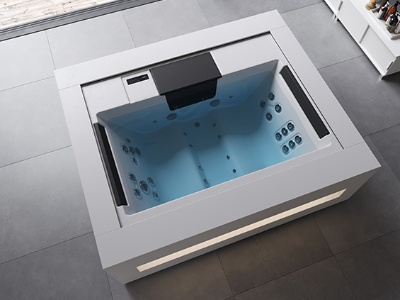
Maintaining a swimming pool requires the use of various products to ensure that the water is healthy, clear and pleasant for swimming. Without proper treatment, the water can quickly become cloudy, promote the proliferation of bacteria and damage equipment. To ensure optimal water quality, it is essential to choose the right products and use them correctly. Here is an overview of the main maintenance products for your pool and their specific roles.
Chlorine: the main disinfectant
Chlorine is the most commonly used product for disinfecting pool water. It eliminates bacteria, viruses and micro-organisms that can develop in stagnant water. Its popularity is due to its effectiveness and relatively affordable cost.- Available forms: It comes in the form of tablets, granules or liquid. The tablets are generally placed in a skimmer or floating dispenser, while the liquid version is often used in automatic treatment systems.
- Dosage: The recommended chlorine level is between 1 and 3 mg/L. Too high a dosage can cause skin and eye irritation, while too low a level allows bacteria to proliferate.
- Shock treatment: In case of cloudy water or heavy use of the pool, shock chlorination can quickly restore an effective level of disinfection.
Bromine: an effective and gentle alternative
Less irritating than chlorine, bromine is an excellent alternative, especially for heated pools. It is more stable at high temperatures and remains active for longer, even under the effect of UV rays.- Advantages: Bromine is odourless, does not cause irritation and remains effective even when the pH of the water is slightly unbalanced.
- Dosage: A level of 1 to 2 mg/L is recommended for optimal effectiveness.
- Cost: It is slightly more expensive than chlorine, but its prolonged effectiveness makes it a worthwhile investment for owners of heated or indoor pools.
pH correctors
A good pH balance is crucial to ensure the effectiveness of cleaning products and the comfort of bathers. An incorrectly adjusted pH can cause various problems:- pH too low (< 7.2): The water becomes acidic, which can cause skin and eye irritation, as well as corrosion of equipment.
- pH too high (> 7.6): The effectiveness of chlorine is reduced, promoting the growth of algae and lime deposits.
- pH Plus: Used to increase the pH when it is too acidic.
- pH Minus: Reduces alkalinity and stabilises the water if the pH is too high.
Anti-algae: prevention and treatment
Algae can invade a swimming pool in a matter of days if maintenance is neglected. To avoid this problem, the use of a preventive anti-algae treatment is strongly recommended.- Preventive anti-algae: Added regularly, it prevents the proliferation of algae before they settle.
- Curative treatment: In the case of green water, a shock anti-algae combined with intense chlorination restores crystal-clear water.
- Clarifiers: They work by making the particles finer, which improves their capture by the filter.
- Flocculants: They agglomerate the impurities by forming larger flakes, which are then eliminated by suction.
Anti-limescale products
If your water is hard, it can cause limescale deposits on the walls and in the filtration system.- Consequences: Excessive limescale can block pipes, reduce heating efficiency and clog the filter.
- Solution: An anti-limescale product prevents the build-up of deposits and protects equipment.
Buying guide: which products should you choose for effective maintenance?
With a wide range of maintenance products on the market, it is important to choose the right ones for your type of pool and your specific needs.- Chlorine pools: Opt for multifunctional pebbles that combine chlorine, anti-algae and stabiliser for simplified maintenance.
- Bromine pools: Choose bromine tablets and a diffuser for continuous release.
- Active oxygen pools: This environmentally friendly treatment is gentle on the skin but requires more rigorous monitoring.




